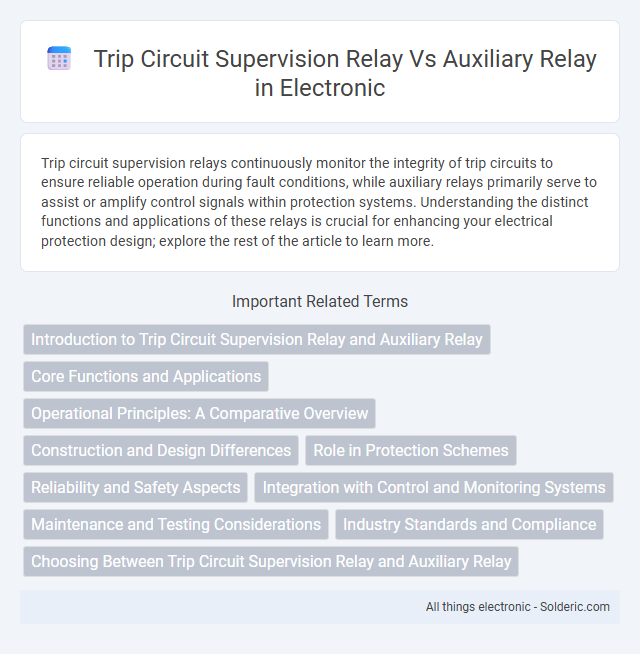Trip circuit supervision relays continuously monitor the integrity of trip circuits to ensure reliable operation during fault conditions, while auxiliary relays primarily serve to assist or amplify control signals within protection systems. Understanding the distinct functions and applications of these relays is crucial for enhancing your electrical protection design; explore the rest of the article to learn more.
Comparison Table
| Feature | Trip Circuit Supervision Relay | Auxiliary Relay |
|---|---|---|
| Primary Function | Monitors integrity of the trip circuit to ensure proper breaker operation | Provides auxiliary control functions in protection and control circuits |
| Application | Power system protection, circuit breaker supervision | General switching, interlocking, signal amplification |
| Operational Role | Detects open or faulty trip circuits to trigger alarms or block trips | Performs logical functions, timing, or signal transfer in control schemes |
| Criticality | High -- ensures reliable breaker tripping for system safety | Varies -- supports protection systems indirectly |
| Typical Design | Supervisory circuit with self-check mechanisms | Electromechanical or solid-state relay with versatile configurations |
| Outcome upon Failure | Alerts operators to trip circuit faults, preventing unsafe breaker operation | May cause control signal loss or improper operation of connected devices |
Introduction to Trip Circuit Supervision Relay and Auxiliary Relay
Trip Circuit Supervision Relay monitors the integrity of the trip circuit to ensure reliable operation of circuit breakers by detecting open or short circuits in the wiring. Auxiliary Relay functions as an intermediary device that provides control logic and signal amplification without directly supervising trip circuits. Both relays are essential in electrical protection systems, but the Trip Circuit Supervision Relay specifically safeguards the trip command path, whereas the Auxiliary Relay supports auxiliary control operations.
Core Functions and Applications
Trip Circuit Supervision Relays ensure continuous monitoring of the trip circuit's integrity, detecting faults or open circuits to guarantee reliable operation of protective relays in power systems. Auxiliary Relays serve as intermediaries, facilitating control logic and signal amplification within electrical panels, often driving other devices or indicating status changes. Your optimal relay choice depends on whether you require critical safety monitoring with Trip Circuit Supervision Relays or versatile control functions with Auxiliary Relays.
Operational Principles: A Comparative Overview
Trip circuit supervision relays specifically monitor the integrity of trip circuits by detecting voltage drops and circuit discontinuities to ensure reliable operation of protection devices. Auxiliary relays function as control switches within protection schemes, responding to input signals to initiate actions without directly monitoring trip circuit condition. Both relays play distinct roles in electrical protection systems, with trip circuit supervision relays providing real-time health status of trip circuits and auxiliary relays offering versatile control and signal transmission capabilities.
Construction and Design Differences
Trip circuit supervision relays are designed with built-in monitoring features to ensure the integrity of the trip circuit, often incorporating test buttons and LED indicators for status verification. Auxiliary relays generally have a simpler construction, focusing on switching operations without specialized supervision components or diagnostic functions. Your selection depends on the need for enhanced trip circuit reliability, with trip circuit supervision relays providing advanced construction tailored for continuous monitoring and fault detection.
Role in Protection Schemes
Trip circuit supervision relays monitor the continuity and integrity of trip circuits to ensure reliable operation of circuit breakers during fault conditions. Auxiliary relays provide control and signaling functions by amplifying or modifying input signals within protection schemes without directly supervising trip circuits. Both relays are essential components in protection systems, with trip circuit supervision relays guaranteeing breaker trip capability and auxiliary relays facilitating interlocking, indication, and sequence control.
Reliability and Safety Aspects
Trip Circuit Supervision Relays enhance safety by continuously monitoring the integrity of trip circuits to prevent false trips or failures, ensuring reliable operation in critical protection systems. Auxiliary Relays support control circuits by providing additional contact functions but do not offer direct supervision, making them less critical for safety assurance. For your protection system, prioritizing Trip Circuit Supervision Relays increases overall reliability and minimizes the risk of undetected circuit faults.
Integration with Control and Monitoring Systems
Trip Circuit Supervision Relays seamlessly integrate with control and monitoring systems to provide real-time feedback on the status of trip circuits, enhancing the reliability and safety of electrical protection schemes. Auxiliary Relays serve as interface elements within these systems, enabling flexible control signal routing and status indication without direct trip circuit monitoring capabilities. Your choice between these relays depends on whether you require direct supervision of trip circuits or general auxiliary control functions within the automation framework.
Maintenance and Testing Considerations
Trip Circuit Supervision Relays require regular testing to ensure continuous monitoring of the trip circuit integrity, preventing unnoticed failures that could compromise system safety. Auxiliary Relays, while simpler, also need periodic functional checks to verify proper operation but generally involve less complex maintenance. Your maintenance schedule should prioritize Trip Circuit Supervision Relays due to their critical role in protection schemes, using test procedures that simulate fault conditions to confirm relay responsiveness.
Industry Standards and Compliance
Trip circuit supervision relays and auxiliary relays must comply with stringent industry standards such as IEC 60255 and IEEE C37.90 to ensure reliable operation in power system protection. Trip circuit supervision relays specifically monitor the continuity of trip circuits for fault isolation, aligning with safety regulations to prevent malfunctions. Your choice of relay should meet these compliance requirements to guarantee effective protection and system reliability.
Choosing Between Trip Circuit Supervision Relay and Auxiliary Relay
Choosing between a Trip Circuit Supervision Relay and an Auxiliary Relay depends on the application requirements involving protection and control systems. Trip Circuit Supervision Relays provide vital monitoring of the trip circuit integrity, ensuring reliable breaker operation and fault detection, while Auxiliary Relays primarily serve as general-purpose switching devices to support control logic in substations. Prioritizing trip circuit reliability and fault prevention favors Trip Circuit Supervision Relays, whereas simple control signal amplification or logic functions align better with Auxiliary Relays.
Trip Circuit Supervision Relay vs Auxiliary Relay Infographic

 solderic.com
solderic.com